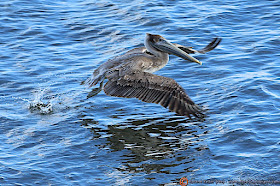 |
Avec une grande profondeur de champ, on arrive à voir la fusée Falcon (l'étage inférieur) sur le pas de tir 40
dans lemme axe que le pas de tir 39A, de SpaceX. - Photo : rke |
[Cape Canaveral, Florida, January 4, 2018,
rke –
English below]
– Partir à la chasse au lièvre ou au sanglier – c’est assez répandu en Suisse –
apporte une petite dose d’adrénaline. Quoique. S’en aller à la chasse d’une
fusée, amène aussi de l’aventure. Quel plaisir avons-nous donc, chacun des photographes
sur place, ici à Cap Canaveral à vouloir immortaliser un bout de fusée ? Parce
que c’est bien un bout qu’on voit en ce moment. Il faut dire que l’événement
est un peu spécial. Nous avons un lancement top-secret que SpaceX nous cache.
Être à l’affût au bon moment, s’imprégner de l’environnement, se sentir dans
l’événement, voilà ce qui motive.
 |
Quel est cet oiseau perché ? Un vautour !
Avec au loin le pas de tir 39B.
Photo : rke |
Du coup, je me suis mis en piste sur une route
d’une dizaine de km qui longe la plage au nord des tours de la NASA, là où il
encore possible d’avoir un bon œil sur l’ensemble des sites. C’est un peu loin,
mais, parfois, il faut avoir de la distance pour obtenir du champ, d’où la
photo ci-contre avec en premier plan le pas de tir 39A et au fond le 40. Cela à
l’air anodin, ainsi. Mais je puis vous dire que j’ai dû régater. En route, j’ai
découvert un beau vautour – voir
photo – qui m’attendait sur le piquet « Speed Limit 25 » et m’a
montré la direction à suivre. Le centre spatial de la NASA est tout plat. Pour
avoir de la hauteur, j’ai demandé à l’oiseau : « T’as pas un coin
haut ? ». D’un coup d’aile, il s’en est allé. Je l’ai suivi et j’ai
déniché l’endroit idéal sur une bonne pour avoir toutes les tours aux
alentours. La morale de cette histoire, c’est que maître oiseau sur son piquet
perché habite les lieux. Je rappelle que le Centre spatial est sis sur une
réserve naturelle (Merritt Island) qui, ensemble, compte 80 % de la surface du
canton du Jura. Ah, au fait, SpaceX ne nous a pas dit pourquoi sa fusée Falcon
ne possédait pas son « capuchon » ou la coiffe (fairing) en son
sommet (le bout de la fusée, quoi). D’accord, c’est une mission secrète et il
faut seulement tester l’étage inférieur. Sachez aussi que le lancement de Zuma,
ce satellite top-secret, vient d’être repoussé à dimanche 7 janvier. J’ai le
temps de revoir mes oiseaux…
 |
| With a great depth of field (photo), we can see the Falcon rocket (the lower stage) on the launch pad 40 in the same axis as the PAD 39A, of SpaceX. Photo : rke |
SpaceX-Falcon : storming to a ghostly Zuma !
 |
| A lower stage so far away. A ship so near away... - Photo : rke |
[Cape Canaveral, Florida, January 4, 2018,
rke]
- Going hunting for a hare or wild boar – it's quite common in Switzerland –
brings a small dose of adrenaline. Though. Going hunting a rocket, also brings
adventure. What pleasure do we have, each of the photographers on site, here in
Cape Canaveral to want to immortalize a piece of rocket? Because it's a bit (bottom)
we're seeing right now. It must be said that the event is somewhat special. We
have a top-secret launch that SpaceX is hiding from us. Being on the lookout at
the right time, absorbing the environment, feeling in the event, that's what
motivates.
 |
Une Ford Escape (Kuga) avec des
chevaux ! Tiens, voilà enfin des
chevaux - Photo : rke |
So, I started on a road of about ten km along
the beach north of NASA towers, where it still possible to have a good eye on
all launch pads. It's a bit far, but sometimes you have to have distanced to
get the field. Whence this photo (opposite) with foreground shot 39A and bottom
40. That looks innocuous, as well. But I can tell you that I had to race. On
the way, I discovered a beautiful vulture –
see picture – who was waiting for me on the picket "Speed Limit
25" and showed me the direction to be continued. The NASA Space Center is
all flat. To get some height, I asked the bird, "You do not have a high
wedge for me? ". With one stroke of the wing, the bird went away. I
followed it and I found the perfect place on a good to have all the rounds
around. Finally, master bird on its perched stake lives in the place. I recall
that the Space Center is located on a nature reserve (Merritt Island) which,
together, accounts for 80% of the surface of Jura canton (Nord of Switzerland).
Oh, by the way, SpaceX did not tell us why its Falcon rocket did not have fairing
at its top. Okay, it's a secret mission and it’s just a test of the bottom stage.
Be aware that the launch of Zuma, this top-secret satellite, has been postponed
to Sunday, January 7. I have time to see my birds again ...




























